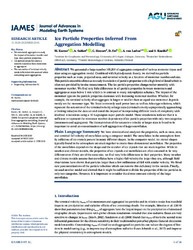Ice Particle Properties Inferred From Aggregation Modelling
DOI: https://doi.org/10.1029/2020MS002066
Persistent URL: http://resolver.sub.uni-goettingen.de/purl?gldocs-11858/9218
Persistent URL: http://resolver.sub.uni-goettingen.de/purl?gldocs-11858/9218
Karrer, M.; Seifert, A.; Siewert, C.; Ori, D.; von Lerber, A.; Kneifel, S., 2020: Ice Particle Properties Inferred From Aggregation Modelling. In: Journal of Advances in Modeling Earth Systems, Band 12, 8, DOI: 10.1029/2020MS002066.
 |
Dokument öffnen: |
We generated a large number 105,000 of aggregates composed of various monomer types and sizes using an aggregation model. Combined with hydrodynamic theory, we derived ice particle properties such as mass, projected area, and terminal velocity as a function of monomer number and size. This particle ensemble allows us to study the relation of particle properties with a high level of detail which is often not provided by in situ measurements. The ice particle properties change rather smoothly with monomer number. We find very little differences in all particle properties between monomers and aggregates at sizes below 1 mm which is in contrast to many microphysics schemes. The impact of the monomer type on the particle properties decreases with increasing monomer number. Whether, for example, the terminal velocity of an aggregate is larger or smaller than an equal-size monomer depends mostly on the monomer type. We fitted commonly used power laws as well as Atlas-type relations, which represent the saturation of the terminal velocity at large sizes (terminal velocity asymptotically approaching a limiting value) to the data set and tested the impact of incorporating different levels of complexity with idealized simulations using a 1D Lagrangian super particle model. These simulations indicate that it is sufficient to represent the monomer number dependency of ice particle properties with only two categories (monomers and aggregates). The incorporation of the saturation velocity at larger sizes is found to be important to avoid an overestimation of self-aggregation of larger snowflakes.
Statistik:
ZugriffsstatistikSammlung:
Schlagworte:
agreggation modelingcloud microphysics
ice particle properties
Lagrangian modeling
terminal velocity
This is an open access article under the terms of the Creative Commons Attribution License, which permits use, distribution and reproduction in any medium, provided the original work is properly cited.

